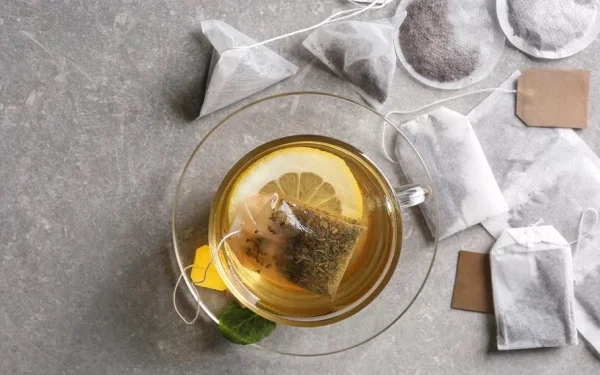Plastic Particles Found in Tea: A Dangerous Revelation for Health and Environment
A shocking revelation from multiple scientific studies has raised serious concerns among tea lovers worldwide. Researchers have discovered that tea bags—especially those made of nylon or sealed with polypropylene—release millions of microplastic and nanoplastic particles into hot water during brewing. This finding has sparked a global debate on food safety, environmental pollution, and the need for urgent regulatory measures.
How the Discovery Was Made
Over the past decade, scientists have been increasingly studying microplastics in food and beverages. The latest research, conducted by scientists at McGill University in Canada and corroborated by other independent studies, has shown that a single cup of tea brewed using nylon or polypropylene-sealed tea bags can contain up to 11.6 billion microplastic particles and 3.1 billion nanoplastic particles.
The process is simple but alarming: when boiling water—often exceeding 90°C—is poured over these tea bags, the heat causes the synthetic materials to break down, releasing tiny plastic fragments into the tea.
What Are Microplastics and Nanoplastics?
- Microplastics: Plastic particles smaller than 5 millimeters but larger than 1 micrometer.
- Nanoplastics: Even tinier particles, smaller than 1 micrometer, often invisible to the naked eye.
Both types can travel through the digestive system and, according to emerging research, may even enter the bloodstream, accumulate in organs, and cross the blood-brain barrier.
Health Risks of Consuming Plastic-Laced Tea
The potential health impacts of ingesting microplastics and nanoplastics are still under investigation, but preliminary findings are troubling. Possible long-term health effects include:
- Hormonal Disruption
Certain plastics contain endocrine-disrupting chemicals (EDCs) that can interfere with hormone regulation, affecting fertility, metabolism, and growth. - Digestive Disorders
Microplastics may cause inflammation in the gut, disrupt gut bacteria balance, and contribute to conditions like irritable bowel syndrome (IBS). - Increased Cancer Risk
Some plastic compounds, especially when exposed to heat, can release carcinogenic substances. - Immune System Stress
Chronic exposure may weaken the immune system, making the body more susceptible to infections. - Neurological Concerns
Nanoplastics, due to their size, can potentially reach the brain, raising concerns about cognitive and neurological health.
Global Research Findings
- European Food Safety Authority (EFSA): Acknowledges growing evidence that humans ingest microplastics through seafood, drinking water, and now, tea.
- World Health Organization (WHO): Calls for more research but warns of potential health implications.
- Studies in Asia: Found that populations with high tea consumption could face higher microplastic exposure compared to other dietary sources.
Environmental Impact
Apart from health risks, the environmental consequences are severe. Discarded nylon or polypropylene tea bags do not fully biodegrade, contributing to long-lasting plastic pollution in soil and water bodies. Microplastics from these bags can eventually enter rivers, oceans, and the food chain, harming marine life and indirectly returning to humans through seafood consumption.
Safer Alternatives for Tea Lovers
Experts recommend switching to eco-friendly options:
- Loose-Leaf Tea: Brewed using stainless steel or glass infusers—completely plastic-free.
- Paper Tea Bags: Ensure they are unbleached and compostable, without polypropylene sealing.
- Biodegradable Plant-Based Bags: Made from cornstarch or other plant fibers, though consumers should check for certifications.
- Ceramic Teapots: Traditional brewing methods eliminate plastic exposure entirely.
Tips to Reduce Microplastic Intake from Tea
- Avoid boiling water in plastic kettles—use stainless steel or glass kettles instead.
- Read packaging labels carefully to identify materials used in tea bags.
- Choose reputable brands that openly declare their tea bag composition.
- Brew at slightly lower temperatures (80–85°C) for green or white teas to reduce plastic degradation.
Industry and Regulatory Response
The tea industry has come under increasing pressure to adopt safer materials. Some brands in Europe and North America have pledged to phase out plastic tea bags entirely, replacing them with compostable alternatives. However, in many developing countries, regulatory oversight is minimal, and cheap plastic-sealed tea bags remain the norm.
Health advocates are urging:
- Government regulations requiring full disclosure of tea bag materials.
- Bans on nylon and polypropylene in food-contact items.
- Consumer awareness campaigns to educate people on safe brewing practices.
The Bigger Picture: Microplastics in Our Diet
This revelation about tea is part of a broader concern: microplastics have been found in salt, bottled water, seafood, honey, fruits, vegetables, and even the air we breathe. According to a recent study in Environmental Science & Technology, the average person may consume up to 50,000 microplastic particles per year—and tea bags are now confirmed as a major contributor for regular tea drinkers.
Conclusion
The discovery of plastic particles in tea has jolted both the food industry and consumers. While more research is needed to fully understand the health risks, experts agree that prevention is the safest approach. By making informed choices—such as opting for loose-leaf tea or certified biodegradable bags—tea lovers can continue to enjoy their favorite beverage without the hidden dose of microplastics.
The message is clear: the comforting cup of tea should not come with a side of plastic pollution. Both consumers and manufacturers must act now to ensure a healthier future for people and the planet.

























